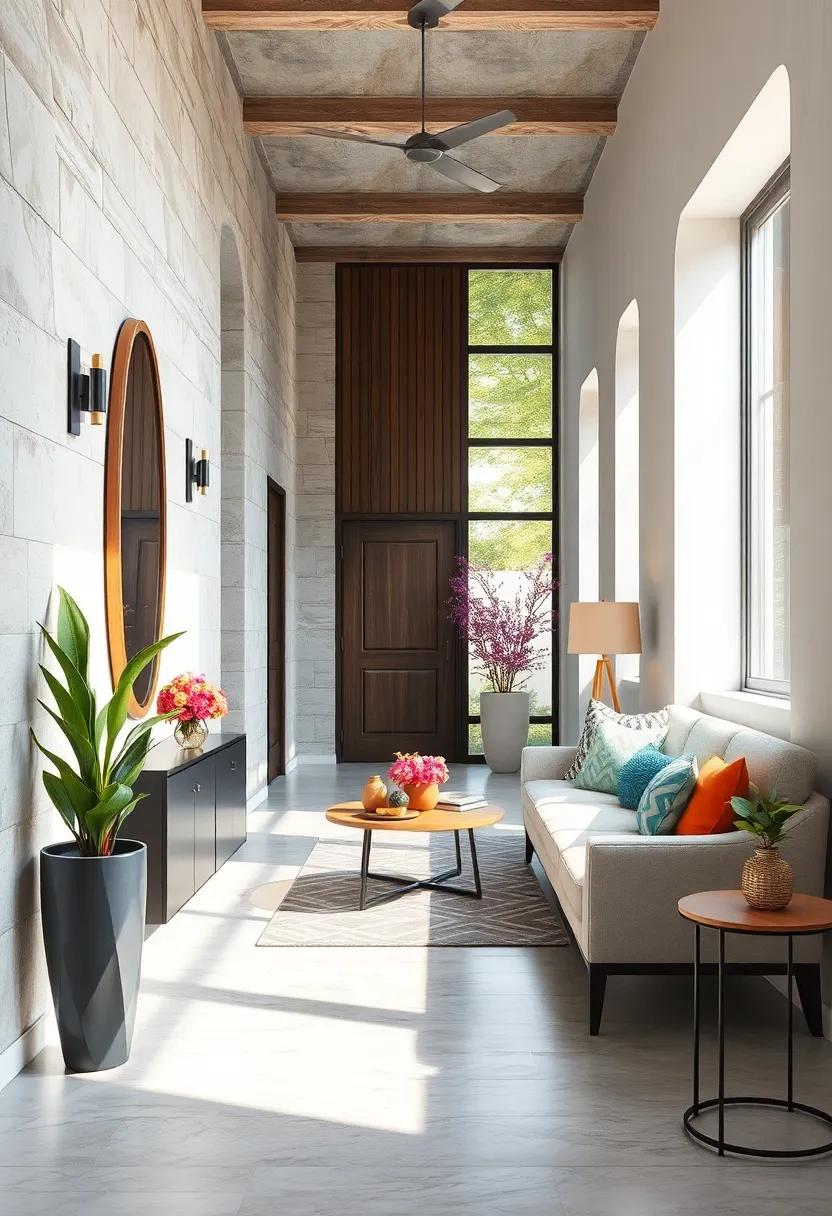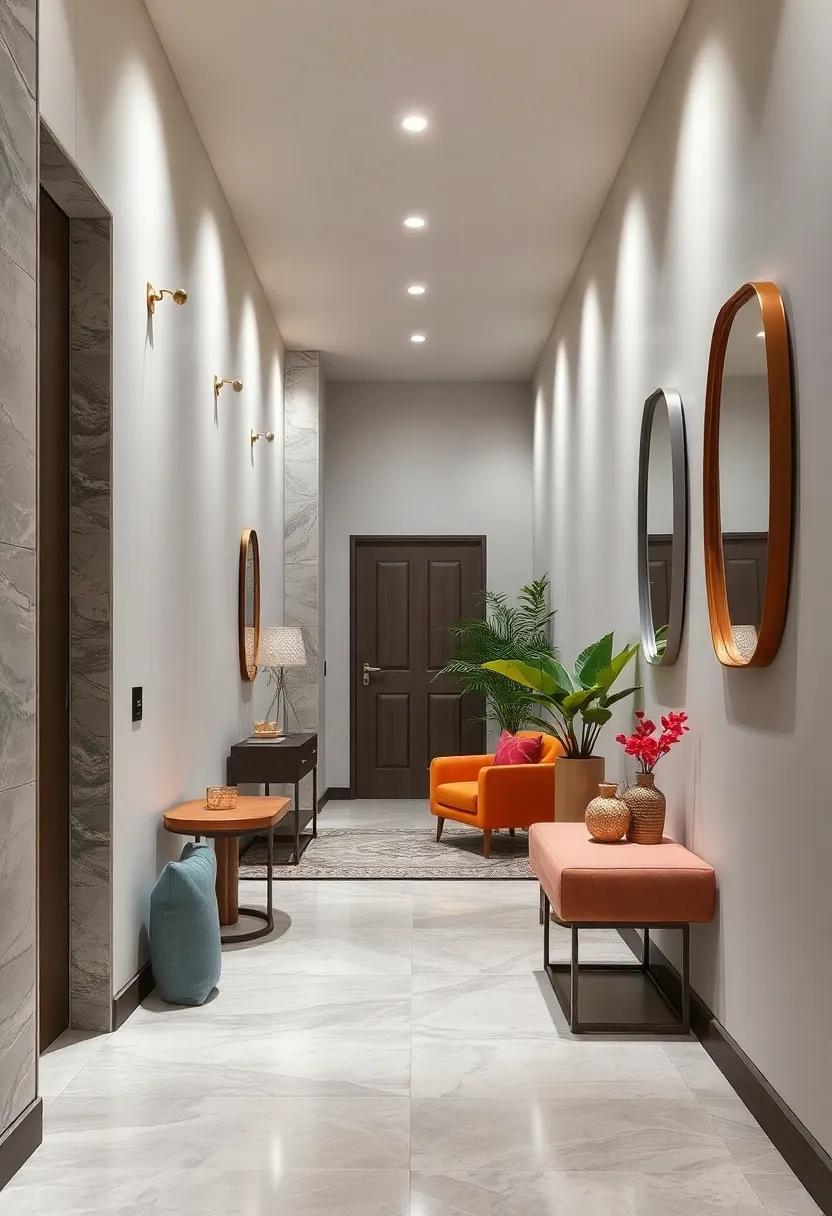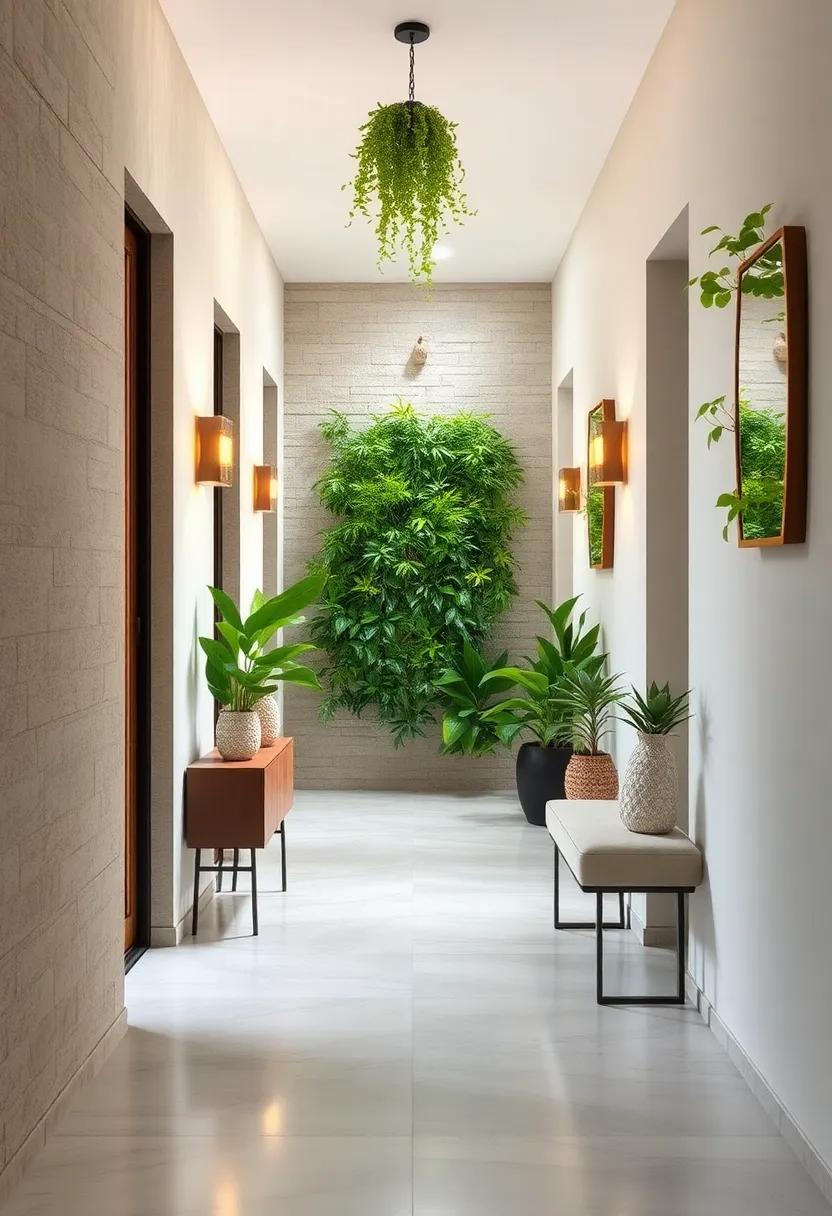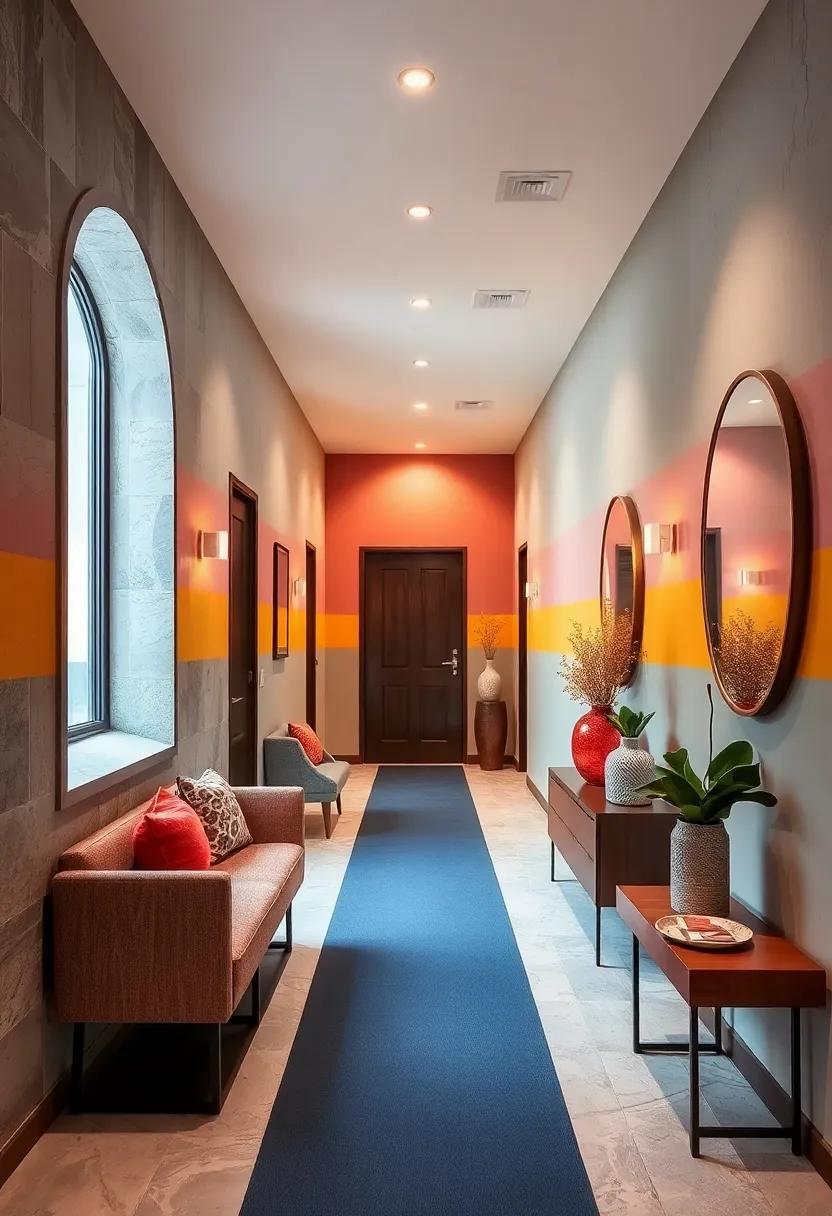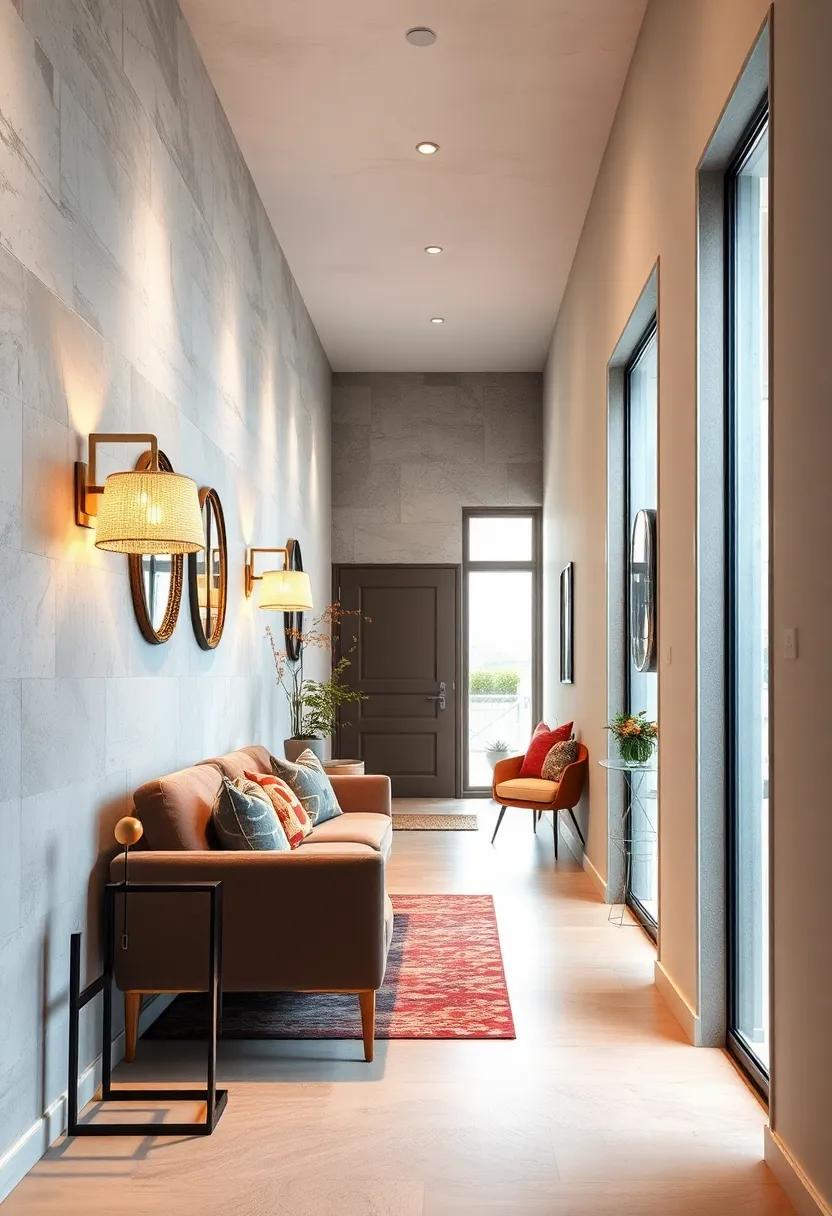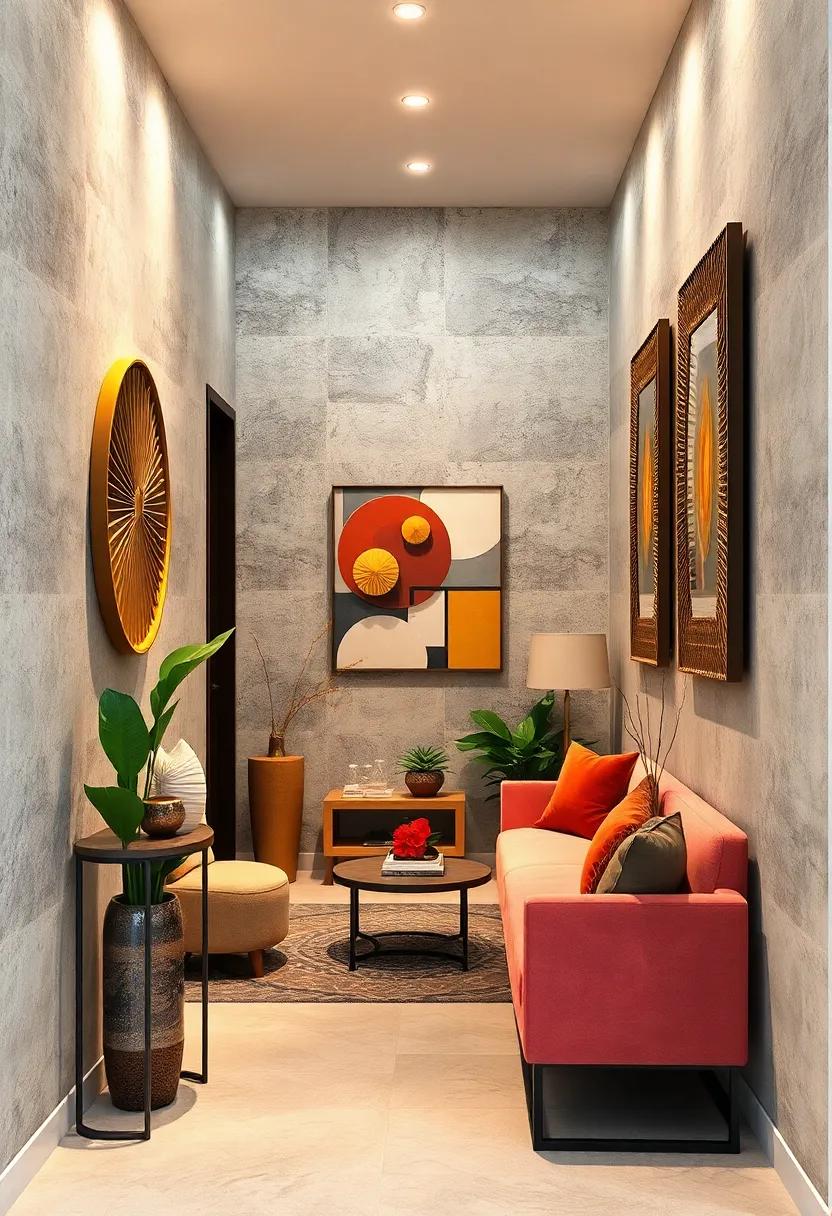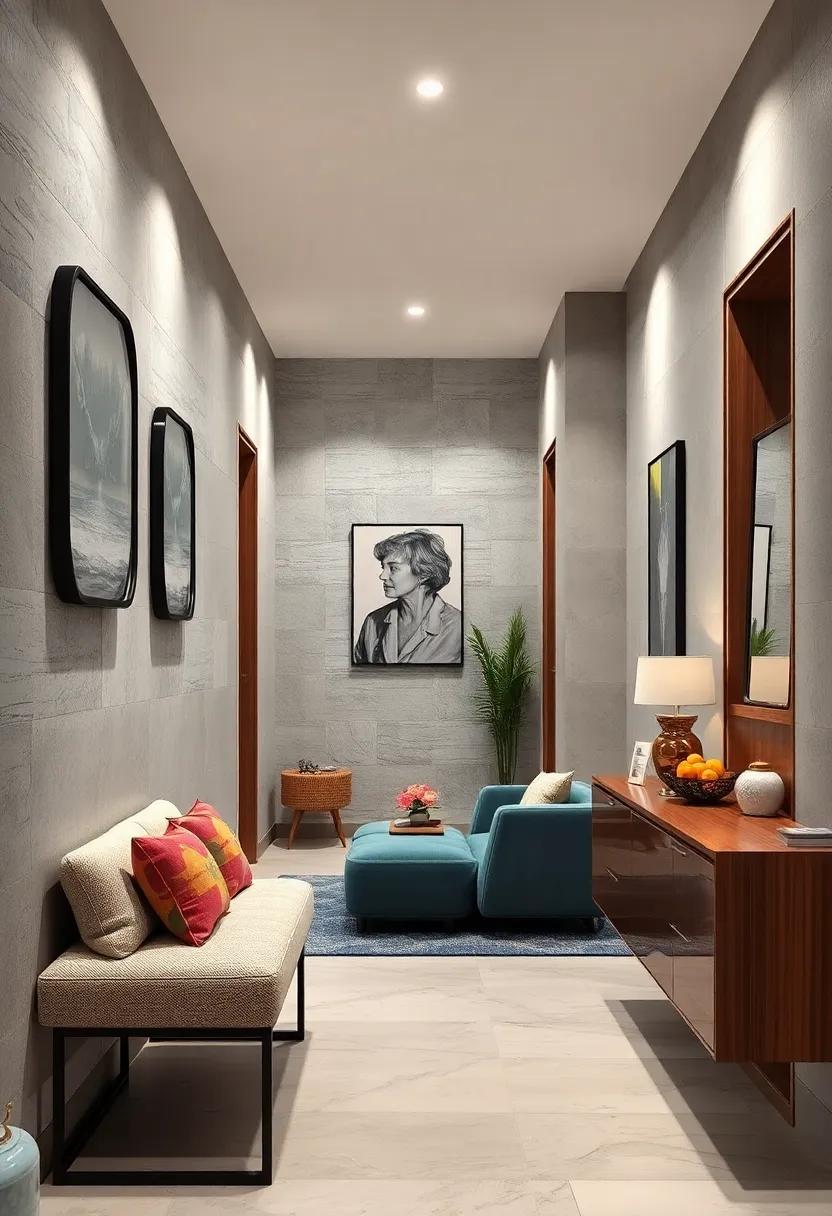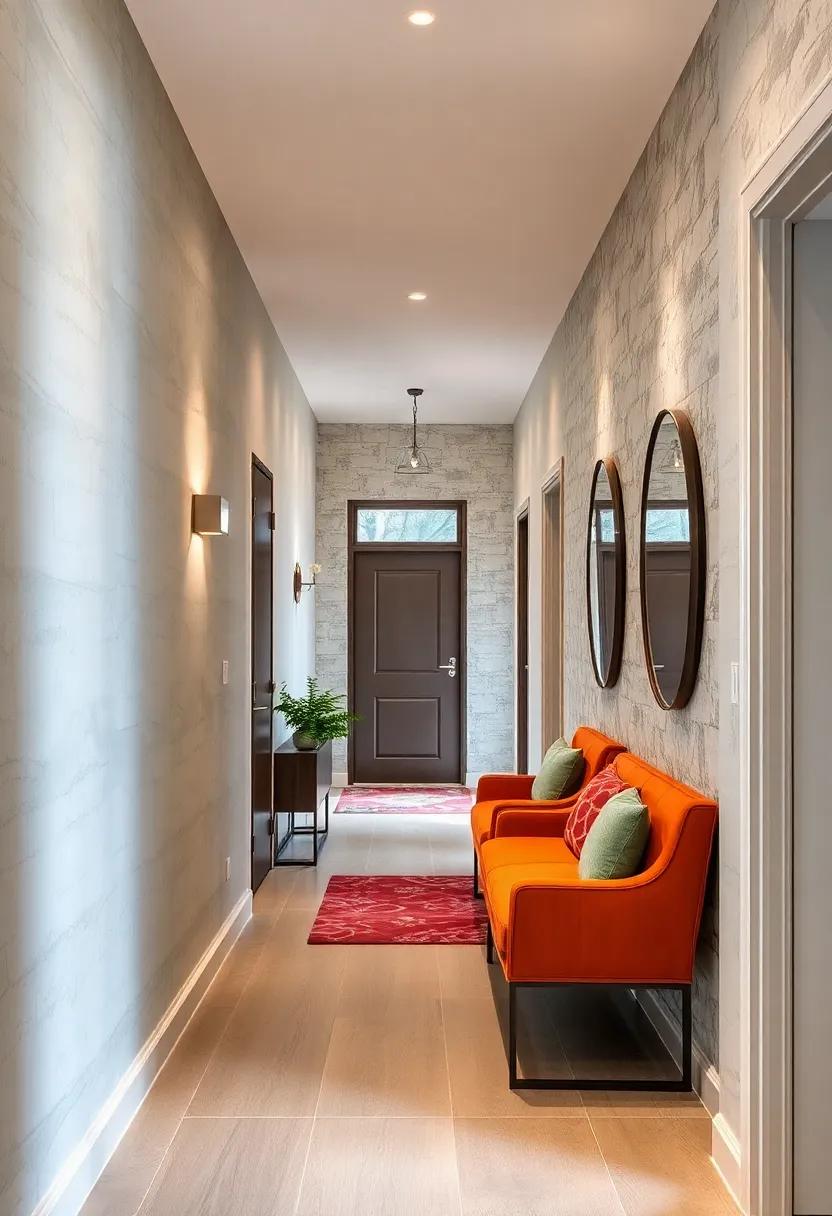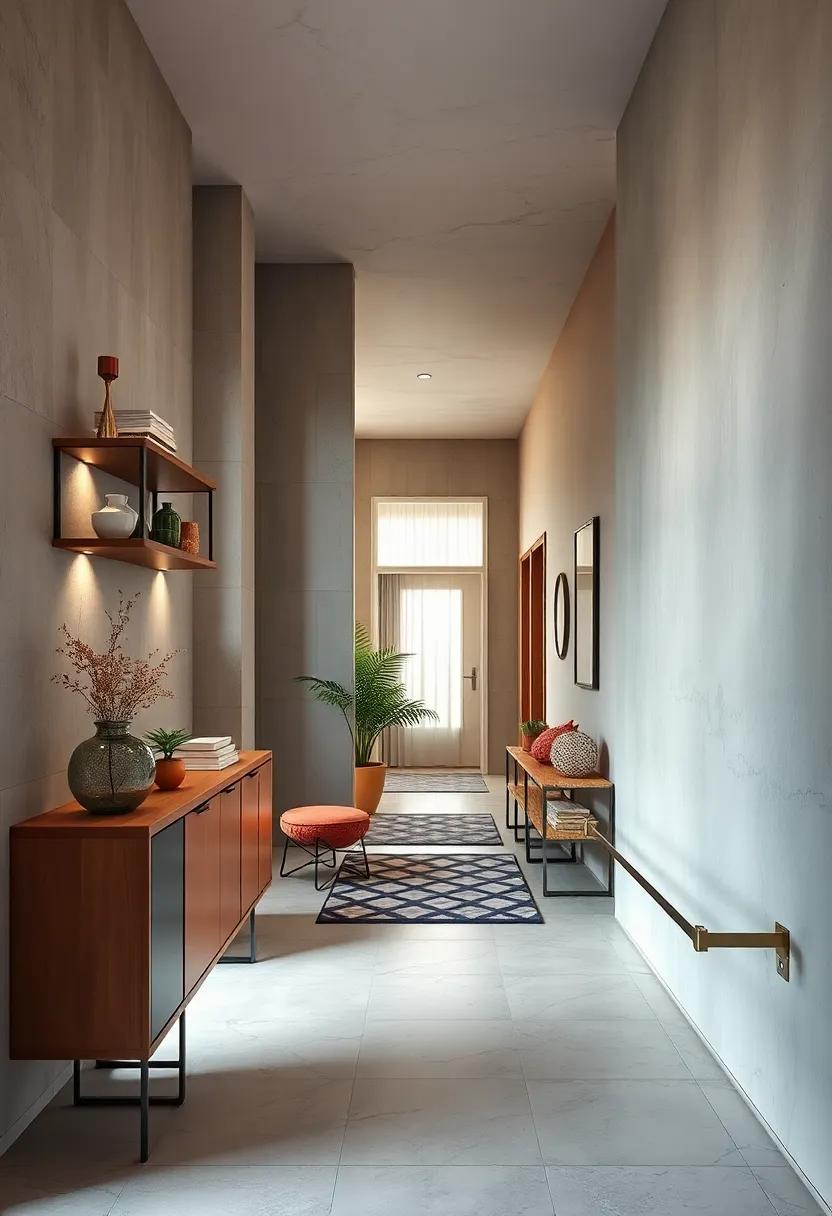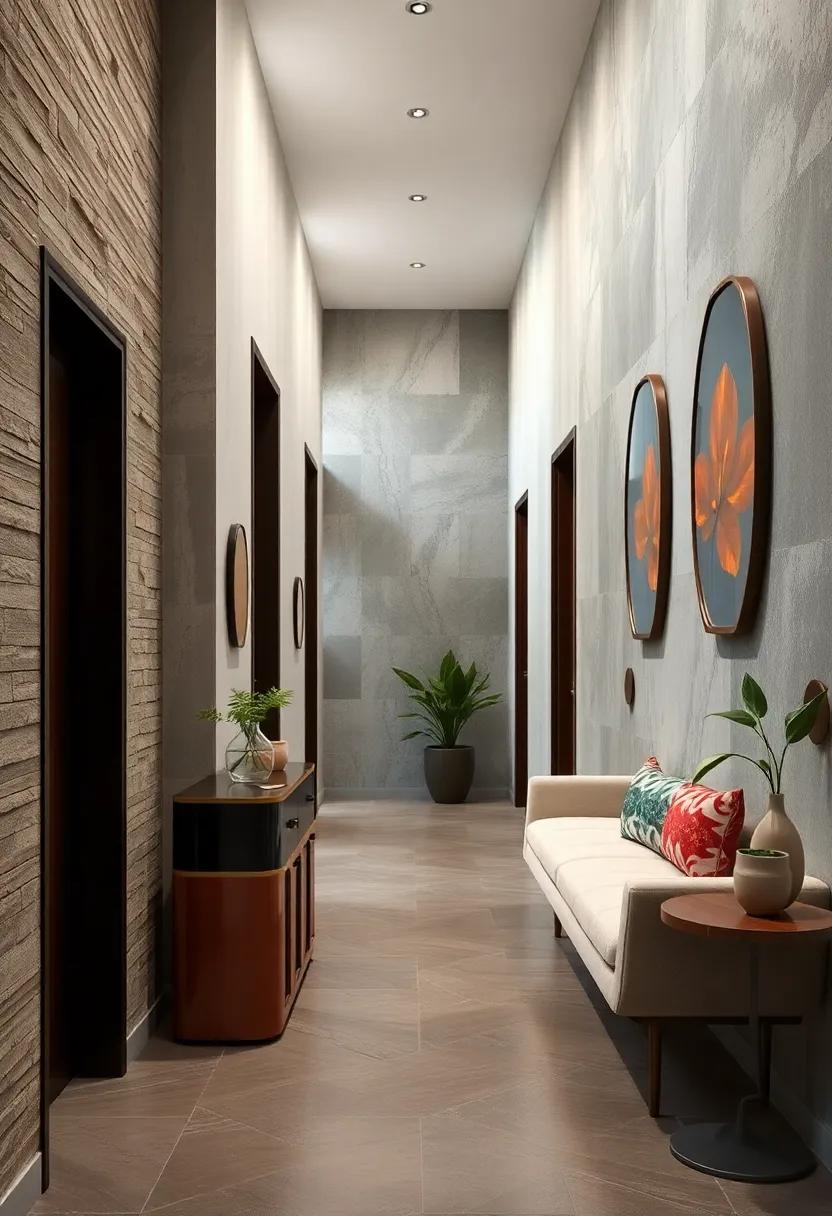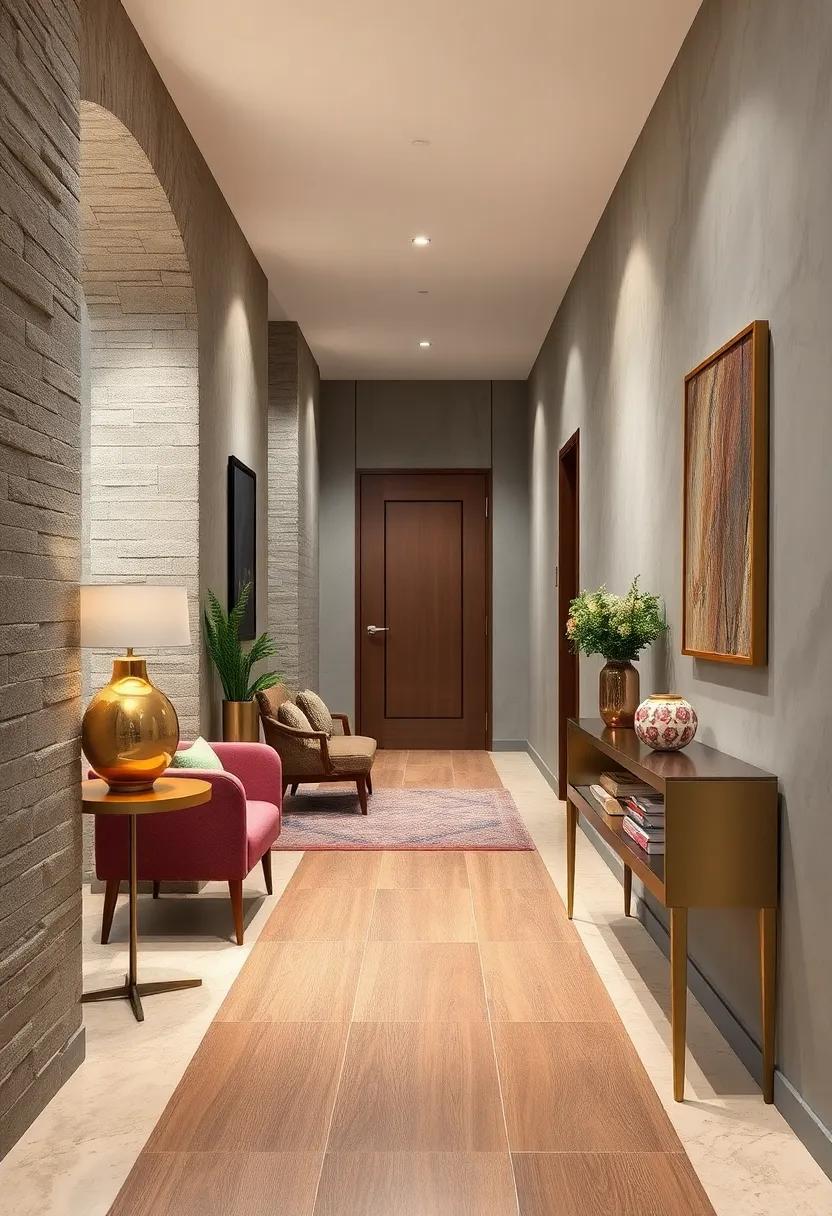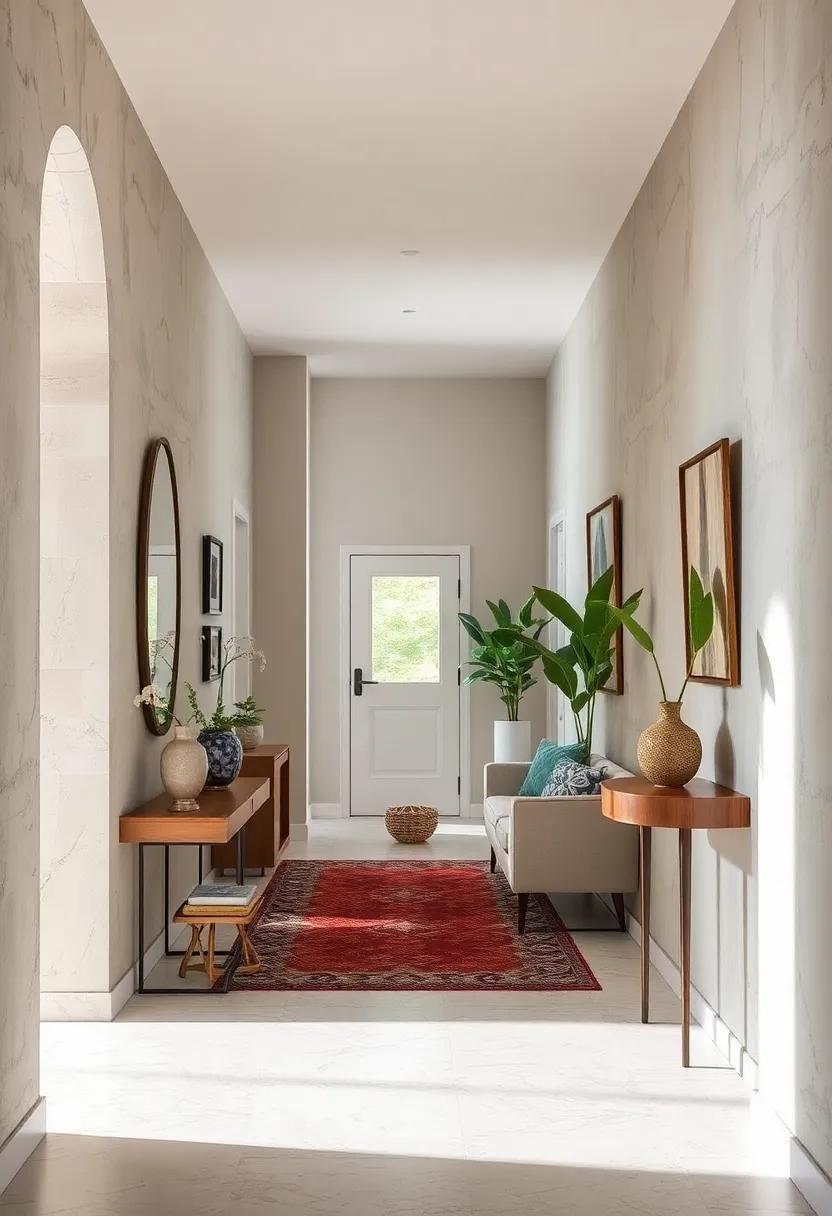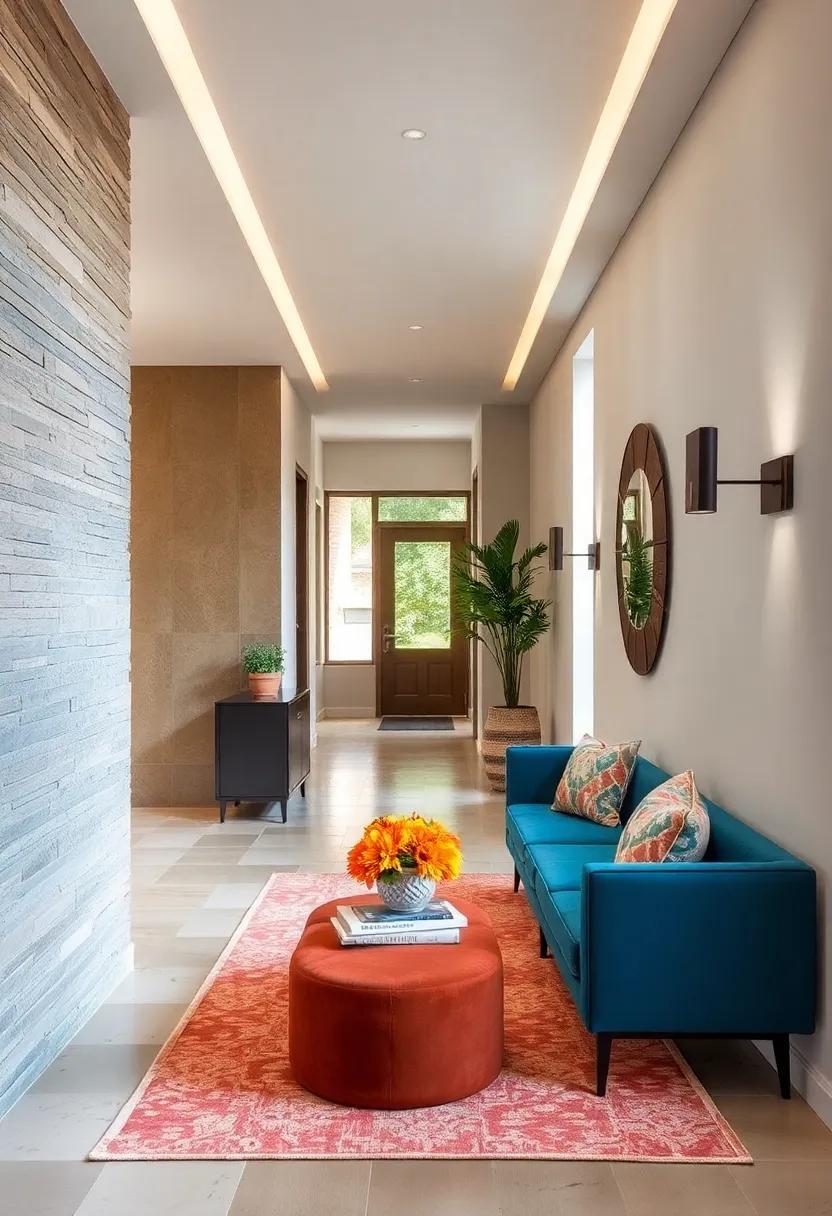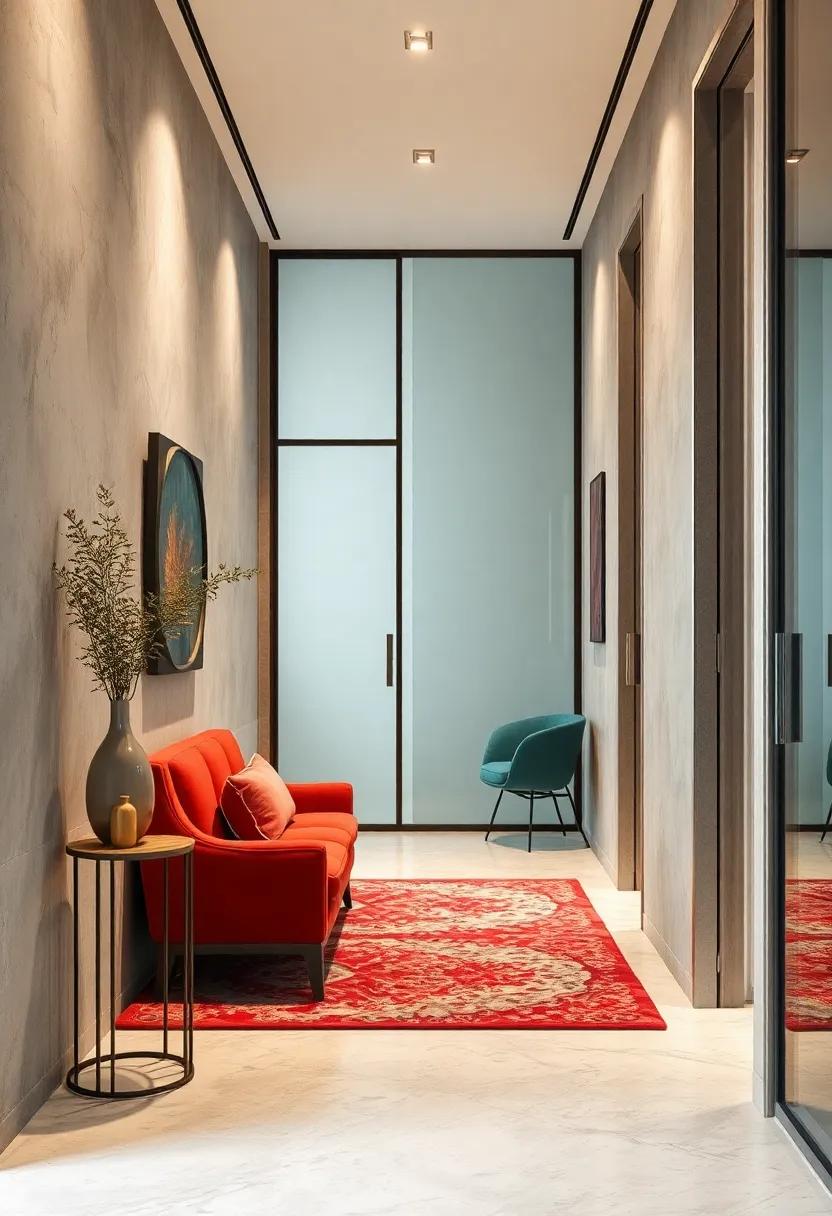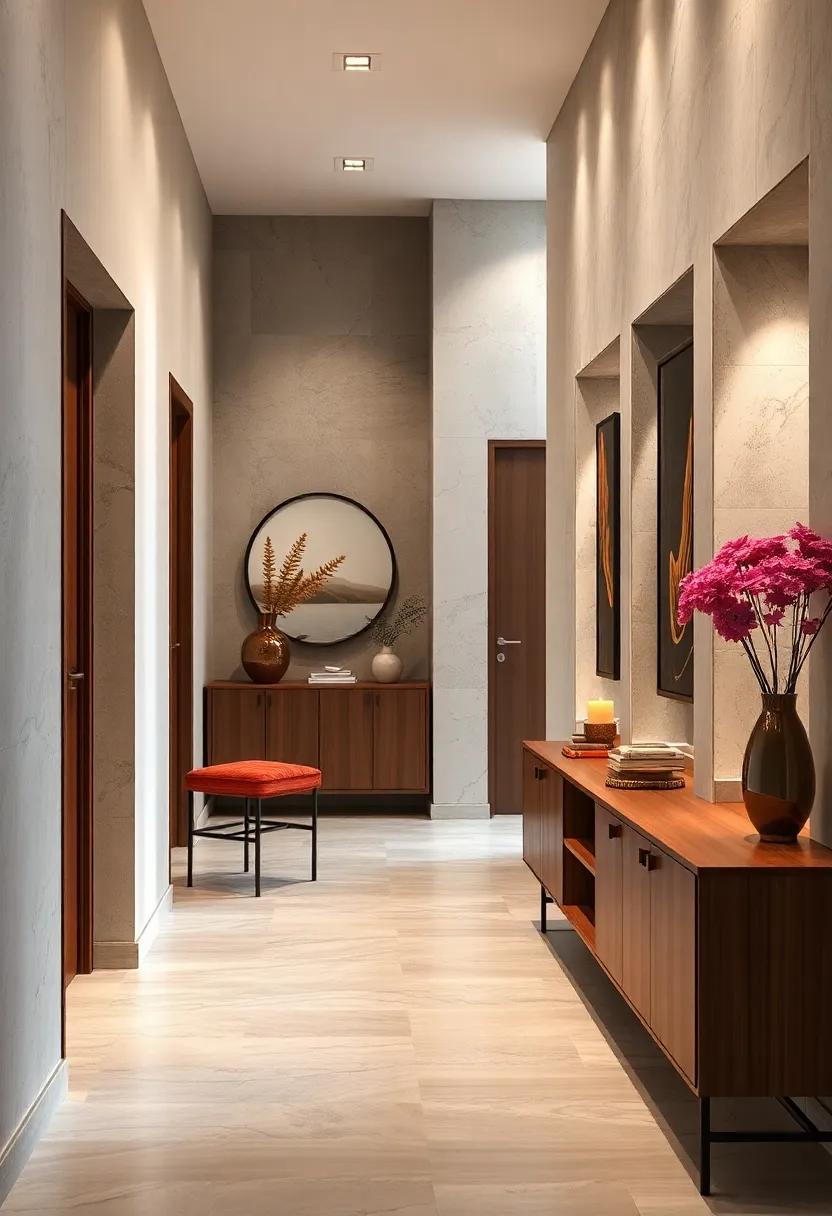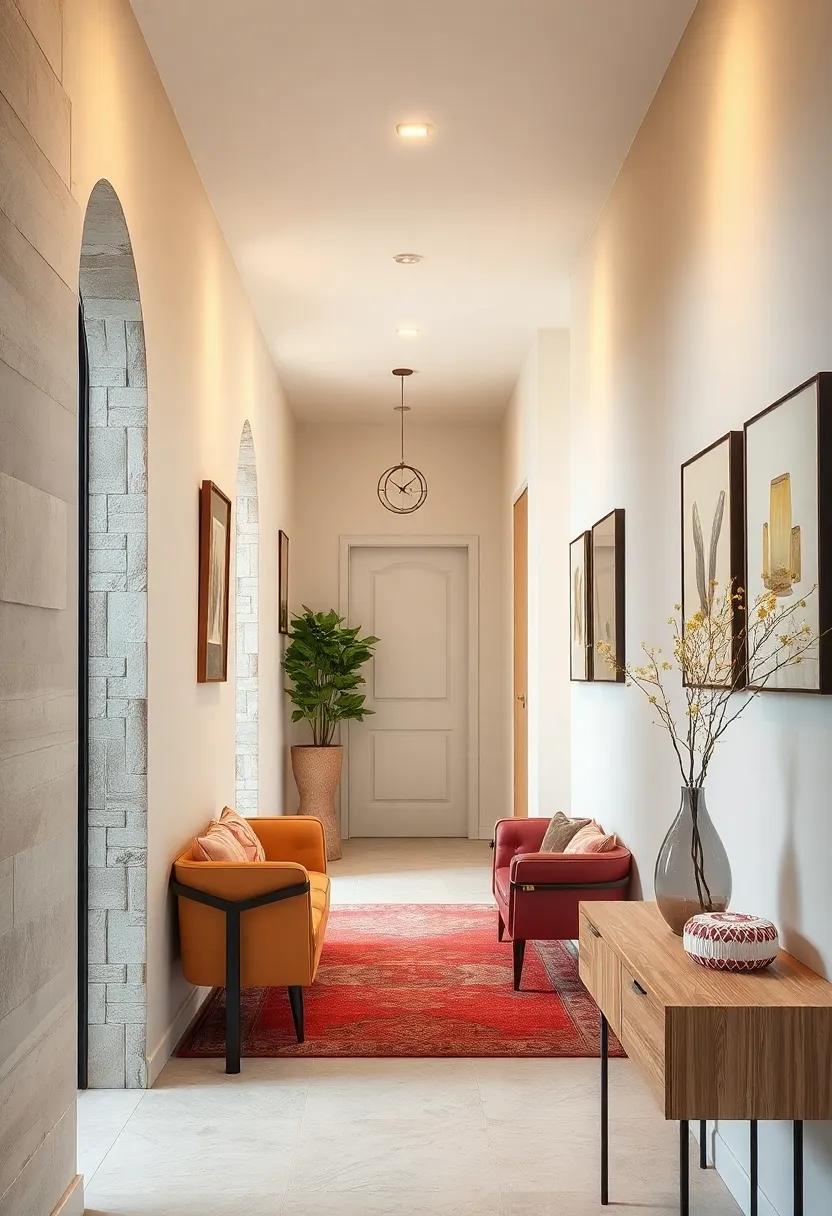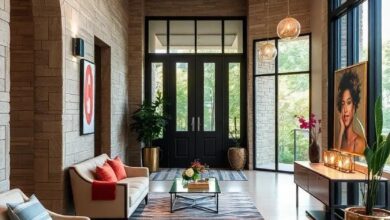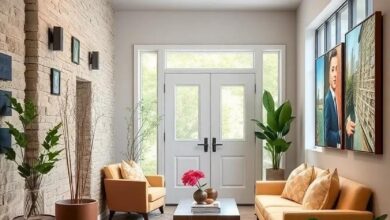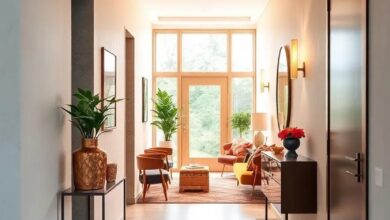Transforming Tight Spaces: Creative Ideas for Narrow Hallway Decorating
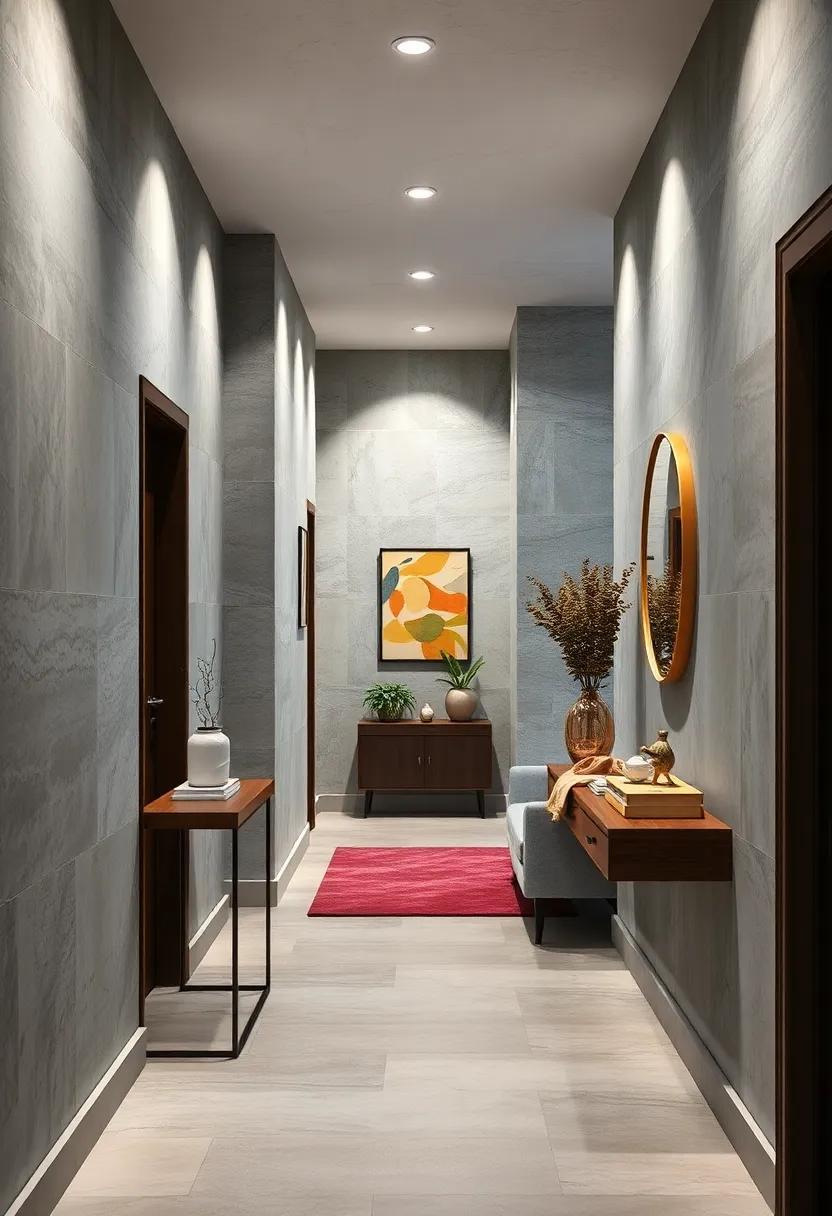
In the world of interior design, narrow hallways often present a unique challenge: how to make a confined space feel inviting rather than constricted. These overlooked corridors, nestled between rooms or serving as mere passageways, hold untapped potential to become striking features of a home. Transforming tight spaces into visually appealing and functional areas requires a blend of creativity and careful planning. This article explores imaginative ideas and practical tips to breathe new life into narrow hallways, proving that even the most modest of spaces can be transformed into charming, purposeful pathways.
Maximizing Natural Light to Open Up Narrow Hallways and Create an Inviting Atmosphere
Harnessing the power of natural light can be a game-changer in transforming narrow hallways into bright, airy passages that welcome you home. Start by installing large, unobstructed windows or even a skylight if your layout allows. These features flood the space with sunlight, visually expanding the walls and making the corridor feel more spacious. Complement these design choices with mirrors strategically placed opposite windows to bounce light around the hallway, doubling its luminosity without any additional fixtures.
Beyond window placement, consider the following tips to enhance natural light’s effect and create a warm ambiance:
- Use light, neutral colors: Opt for soft whites, light grays, or pastels for walls and ceilings to reflect sunlight seamlessly.
- Minimal window treatments: Choose sheer curtains or blinds that filter light gently rather than blocking it entirely.
- Glossy and reflective finishes: Use semi-gloss paint or light-reflective flooring materials to amplify brightness.
| Feature | Benefit |
|---|---|
| Skylights | Invites overhead sunlight, perfect for windowless halls |
| Mirrors | Reflect natural light to increase brightness without clutter |
| Light Paint Colors | Boosts reflection and light diffusion along narrow walls |
Using Mirrored Surfaces to Reflect Light and Add a Sense of Spaciousness in Tight Corridors
Mirrored surfaces are your narrow hallway’s secret weapon when it comes to enhancing light and creating an illusion of depth. By strategically placing mirrors opposite windows or light fixtures, you can double the amount of natural and artificial light bouncing around the space. This reflective magic brightens up what might otherwise feel like a claustrophobic passage, making the corridor feel significantly more open and welcoming. For those worried about overpowering a small space, a sleek, frameless mirror can blend seamlessly into the wall, while mirrored tiles or panels add texture and subtle shimmer without visual heaviness.
To maximize impact, consider these creative placements for mirrors:
- Full-length mirrors at the end of the hallway to visually extend its reach.
- Narrow vertical panels aligned with the corridor’s length to emphasize height and flow.
- Mirrored accents integrated into wainscoting or cabinetry for understated glamour.
| Mirror Type | Effect | Placement Tips |
|---|---|---|
| Full-length | Creates depth | At corridor’s end |
| Vertical strips | Height emphasis | Along sidewalls |
| Panel accents | Subtle sparkle | Within built-in features |
Incorporating Vertical Gardens and Wall Plants to Bring Life and Freshness to Small Hallways
Narrow hallways often suffer from a lack of natural light and space, making them feel confined and uninspiring. Introducing vertical gardens and wall-mounted plants can dramatically alter this perception, infusing the corridor with a burst of vitality and freshness. These living walls act as natural air purifiers, improving the ambience while creating an organic focal point that gently draws the eye upward and along the hallway’s length. Choose lightweight, low-maintenance plants such as ferns, pothos, or succulents to keep upkeep easy and effortless even in tight quarters.
Incorporating these green elements doesn’t require a sprawling space but a bit of creativity and well-placed installation. Consider sleek, narrow planters or modular vertical garden panels that blend seamlessly with your existing decor. To enhance the effect further, use soft LED lighting to highlight plant textures and shadows, giving the hallway a tranquil, botanical vibe. Here’s a quick glance at some popular plant options perfect for vertical gardens:
| Plant Type | Care Level | Light Preference |
|---|---|---|
| Boston Fern | Moderate | Indirect Light |
| English Ivy | Low | Indirect to Low |
| Spider Plant | Low | Bright, Indirect |
| Succulents | Low | Bright Light |
- Maximize wall space: Use vertical garden panels that slimly fit the hallway profile.
- Mix textures: Combine trailing vines with bushy foliage for a layered look.
- Incorporate color: Select plants with varying shades of green and even small flower varieties to brighten the space.
Exploring Bold Color Stripes Running Lengthwise to Enhance the Illusion of Space in Hallways
Using bold color stripes that run lengthwise along the walls of a narrow hallway is a transformative design trick that amplifies the sense of depth and openness. These stripes guide the eye forward, making the corridor feel much longer and inviting. Consider pairing vibrant hues like cobalt blue, fiery red, or lush emerald with crisp white or neutral bases to create striking contrasts that energize the space without overwhelming it. The key lies in consistency and scale-thicker stripes can add drama, while thinner lines contribute to subtle sophistication.
To maximize impact, mix finishes and textures within your stripes. For example:
- Matte paint alongside glossy accents can add tactile intrigue.
- Incorporating metallic touches or textured wallpapers between stripes introduces dimension and luxury.
- Using varying widths in the pattern keeps the eye engaged and breaks monotony.
| Color Pair | Effect | Ideal Hallway Width |
|---|---|---|
| Black & White | Clean, Modern Contrast | 3-4 ft |
| Mustard Yellow & Gray | Warm & Inviting | 2-3 ft |
| Royal Purple & Cream | Elegant & Luxurious | 4-5 ft |
Selecting Sleek and Slim Furniture Pieces that Complement Narrow Hallway Dimensions Without Overcrowding
Opting for furniture designed with narrow hallways in mind means prioritizing pieces that offer both function and form without consuming valuable walking space. Slimline console tables, wall-mounted shelves, and slender benches can add utility while maintaining an airy feel. Keep the color palette light and finishes reflective, such as glass or polished metal, to enhance the perception of openness. Aim for pieces with clean lines and minimal bulk-think tapered legs and open frames-these allow light to pass through and keep the corridor from feeling boxed in.
When selecting furniture, consider dimensions carefully and avoid the temptation to overfill the hallway. A simple layout guide can help visualize proportionality:
| Furniture Type | Recommended Width | Tips for Placement |
|---|---|---|
| Console Table | 12-16 inches | Mount against walls; keep below waist height |
| Wall Shelf | 8-12 inches depth | Use for decorative items; maximize vertical space |
| Slender Bench | 14-18 inches | Place near entryway; avoid obstructing doors |
- Floating furniture stops visual clutter on the floor.
- Multipurpose furniture like storage benches adds convenience without bulk.
- Mirrored or glass elements enhance light and create depth.
By being intentional about scale and style, narrow hallways can transition from cramped to chic, making the most of every inch without sacrificing comfort or creativity.
Creative Wall Art Arrangements Designed to Draw the Eye and Add Personality to Confined Passageways
Narrow passageways offer a unique challenge-and an excellent opportunity-to showcase art and infuse personality without overwhelming the space. Consider a cascading gallery wall with a mix of small framed sketches, vibrant prints, and textured 3D elements that create an engaging visual narrative. Using varied frame sizes and styles adds depth, while staggered arrangement prevents a monotonous linear feel, enticing the eye to wander and explore every detail. Incorporating mirrored frames or metallic finishes can also amplify light and create the illusion of expansiveness, turning even the tightest corridor into a tailored art exhibit.
Layering art doesn’t have to be purely visual-textural contrast plays a pivotal role in adding warmth and dynamism. Integrate unexpected pieces like woven wall hangings or sleek metal sculptures alongside traditional canvases to spark curiosity and tactile interest. Here’s a quick reference table summarizing ideal art types for tight spaces:
| Art Type | Effect | Placement Tip |
|---|---|---|
| Miniature Photography | Intimate, storytelling charm | Cluster near eye level for impact |
| Metal Wall Sculptures | Three-dimensional intrigue | Position singularly to avoid clutter |
| Textured Tapestries | Softens hard lines, adds warmth | Hang against neutral walls |
Lighting Sculptures and Fixtures that Cast Unique Shadows and Highlight the Hallway’s Architecture
Incorporating lighting sculptures and artful fixtures into narrow hallways does more than just illuminate the path-it transforms these confined spaces into dynamic visual experiences. Select fixtures that project intricate patterns or soft, diffused glows, allowing the light to dance off walls and ceilings, creating captivating shadows that amplify architectural details. Consider sculptural pendant lights or wall sconces with perforated designs that cast organic, ever-shifting shapes, turning a simple corridor into a gallery of light and shadow interplay.
To optimize the effect, blend various lighting techniques for layers of depth:
- Accent lighting to emphasize texture or structural elements like molding and paneling.
- Backlighting behind wall fixtures that highlights the hall’s length and draws the eye forward.
- Spotlights aimed at artwork or decorative features to create focal points amidst the shadows.
| Lighting Type | Effect | Best Placement |
|---|---|---|
| Perforated Pendant | Dreamlike shadow patterns | Center of hallway ceiling |
| Artisan Wall Sconce | Highlighting texture and form | Alongside architectural features |
| LED Strip Backlighting | Creates depth and soft ambiance | Under handrails or mouldings |
Innovative Storage Solutions Built into Walls to Keep Narrow Hallways Uncluttered and Stylish
Maximizing functionality without sacrificing style in narrow corridors demands clever storage innovations seamlessly woven into wall designs. Consider recessed shelving that disappears into the wall thickness, providing a sleek display for books, decor or daily essentials without encroaching on precious floor space. Hidden compartments behind removable panels offer secret stashes for items like keys or mail, keeping surfaces pristine. Moreover, wall-mounted fold-out desks or seating units transform these zones into versatile hubs perfect for quick tasks or a moment of pause.
Smart storage ideas to elevate your hallway:
- Built-in cubbies: Combine open and closed sections for aesthetic balance and concealed clutter.
- Integrated coat hooks with shelves: Multi-use surfaces that organize outerwear and small accessories.
- Vertical pull-out drawers: Slim, tall units ideal for shoes or cleaning supplies.
| Storage Type | Ideal For | Style Tip |
|---|---|---|
| Recessed Shelves | Books & Decor | Keep shelf backs painted bright for contrast |
| Hidden Compartments | Keys & Mail | Use magnetic closures for seamless look |
| Pull-out Drawers | Shoes & Accessories | Match drawer fronts to wall paint |
Choosing Textured Wallpapers with Subtle Patterns to Add Depth Without Overwhelming Small Hallways
Narrow hallways often struggle with feeling cramped or monotonous, but the right wallpaper choice can introduce dimension without dominating the space. Opting for textured wallpapers that feature subtle patterns creates a tactile interest, gently enhancing visual depth. Materials like grasscloth, linen, or embossed vinyl can add a sophisticated layer of texture, catching light differently throughout the day and giving the walls a dynamic quality. These small nuances invite the eye to linger, making the hallway feel more inviting rather than oppressive.
When selecting patterns, consider delicate motifs such as fine geometrics, soft florals, or barely-there stripes in muted tones. These designs work beautifully to break up the expanse without making it feel busy or cluttered. Here’s a quick guide to textures and patterns that work best in small corridors:
| Texture | Pattern Style | Effect on Space |
|---|---|---|
| Grasscloth | Subtle weave | Adds warmth & natural depth |
| Linen | Fine crosshatch | Soft, sophisticated visual appeal |
| Embossed Vinyl | Light geometrics | Creates shadow play for dimension |
- Keep colors light: Pale neutrals and soft pastels keep the hallway airy.
- Limit bold contrasts: Avoid overly stark patterns that can overwhelm the space.
- Complement with lighting: Proper illumination highlights textures elegantly.
Designing With Translucent Partitions and Semi-Open Doors to Maintain Flow and Light Through Tight Spaces
Integrating translucent partitions in narrow hallways offers a stunning balance between privacy and openness, allowing natural light to permeate while maintaining distinct zones within tight spaces. Materials like frosted glass, acrylic panels, or even decorative resin can act as subtle dividers that enhance depth without overpowering the area. These semi-transparent barriers serve a dual purpose: they delineate spaces without sacrificing the visual continuity that is crucial in constricted layouts, ultimately preventing the corridor from feeling boxed in or claustrophobic.
Complementing these partitions with semi-open doors-such as sliding or pivot designs with glass inserts-further enhances the sense of flow. These door styles facilitate airflow and light transmission, giving the illusion of expanded space without sacrificing function. Consider the following key advantages:
- Visual expansion: Light travels unhindered, making tight spaces feel airier.
- Sound control: Semi-open doors muffle noise while maintaining openness.
- Flexible privacy: Adjust openness depending on desired separation.
- Sleek aesthetics: Modern materials add sophistication to minimal areas.
| Feature | Benefit |
|---|---|
| Frosted Glass Panels | Permits light flow while obscuring direct views |
| Sliding Semi-Open Doors | Maximizes usable space with flexible entryways |
| Acrylic Partitions | Lightweight, durable, and customizable for unique designs |
Floating Shelves and Minimalist Display Units to Enhance Function and Visual Appeal in Narrow Hallways
Maximize your hallway’s potential by opting for floating shelves and minimalist display units that keep the space open and airy. These sleek additions provide essential storage without encroaching on the limited floor area, allowing for seamless movement. Consider installing a series of staggered floating shelves at different heights to accommodate keys, mail, plants, or decorative items. This layered approach not only adds visual interest but also creates a practical command center within your narrow corridor. Choosing materials like light wood or acrylic can amplify the sense of space while maintaining an understated elegance.
To enhance both function and style, focus on clean lines and simple forms in your display units. Minimalist wall-mounted consoles or slimline cabinets with concealed storage keep clutter at bay and contribute to a streamlined look. Incorporate a few thoughtfully curated pieces-think a single sculptural vase or a framed monochromatic print-to evoke personality without overwhelming the corridor’s dimensions. Below is a quick comparison of storage options perfect for narrow hallways:
| Storage Type | Space Efficiency | Visual Impact | Best For |
|---|---|---|---|
| Floating Shelves | High | Airy, Layered | Display & small items |
| Minimalist Console | Medium | Streamlined, Subtle | Keys & mail |
| Wall Cabinets | High | Tidy, Concealed | Hidden storage |
Emphasizing Floor Patterns and Runners That Guide Movement and Lengthen the Perception of Space
Strategically choosing the right floor patterns and runners can dramatically alter the way a narrow hallway feels. By opting for linear designs-such as elongated stripes, wood planks laid lengthwise, or chevron prints that point forward-you create a visual pathway that naturally draws the eye along the corridor, inviting movement rather than confinement. Colors also play a pivotal role; lighter hues with subtle contrast can reflect light and open up the area, while bold pattern runners add personality without overwhelming the space.
To maximize this effect, consider layering textures and materials in a harmonious way. A plush runner combined with sleek tiled flooring, for example, provides tactile interest and clearly defines the walking area, which can help to elongate the perception of the hallway’s length. Below is a simple guide to selecting floor patterns and runners based on hallway width and style:
| Hallway Width | Recommended Pattern | Suggested Runner Style |
|---|---|---|
| Narrow (2-3 ft) | Thin, vertical stripes | Thin runner, light colors |
| Standard (3-4 ft) | Wide planks, diagonal layout | Patterned runner, medium width |
| Wide (4+ ft) | Chevron or herringbone | Bold, wide runner |
- Tip: Keep runner width proportionate to hallway width-too narrow a runner can break the flow.
- Tip: Use runners with a soft texture to create warmth without adding bulk.
Incorporating Curvy Lines and Soft Shapes to Soften the Rigid Structure of Straight Narrow Hallways
Introducing curvaceous elements into a narrow hallway can dramatically change its aura, turning what might feel like a confined passage into a welcoming, fluid space. Consider installing archways or rounded door frames, which naturally break up the monotony of straight lines. Soft, undulating wall moldings or gentle, wave-like wallpaper patterns can add visual interest without overpowering the limited space. Additionally, decorative features like half-moon mirrors or circular wall art bring softness, encouraging the eye to pause and explore the contours, rather than rush straight ahead.
Textural contrasts can further enhance this effect. Plush, rounded cushions on a slim bench or curved planters with trailing greenery invite touch and interaction, contributing to a cozy, organic vibe. Incorporate these ideas effortlessly with subtle lighting – a row of pendant lights with rounded shades or sconces that mimic natural curves can harmonize the space beautifully. Below is a simple guide for choosing curvy design accents:
| Element | Effect | Example |
|---|---|---|
| Arched Doorframes | Softens edges and adds architectural interest | Rounded wooden door trims |
| Curved Lighting | Creates warm, enveloping light flow | Globe pendant lights |
| Rounded Mirrors | Reflects light and visually expands space | Half-moon hung mirrors |
| Textured Soft Furnishings | Adds tactile warmth and comfort | Velvet cushions on slimset benches |
Using Metallic Accents and Reflective Finishes to Introduce Glamour and Visual Interest in Confined Corridors
In narrow corridors, introducing metallic accents can instantly elevate the ambiance without overcrowding the space. Elements such as gold or brass light fixtures, mirror frames with silver trims, and decorative hooks in bronze offer subtle bursts of luxury and depth. These reflective touches work wonders by bouncing light around the hallway, visually expanding its dimensions and injecting a sophisticated shimmer that animates the entire passageway.
To maximize the glamour effect, blend these metallic features with reflective surfaces like high-gloss paint finishes, acrylic wall panels, or even a strategically placed mirror wall. The interplay of light and shine creates dynamic visual interest that distracts from narrow widths. Here’s a quick guide on pairing metallics with finishes for optimal impact:
| Metallic Accent | Recommended Finish | Effect |
|---|---|---|
| Brushed Brass | Matte Walls | Warm contrast + elegant glow |
| Chrome | High-Gloss Paint | Modern shine + light increase |
| Antique Gold | Mirrored Panels | Opulent depth + reflective brilliance |
| Polished Copper | Glass Fixtures | Vibrant warmth + textural intrigue |
Blending Antique and Modern Décor Elements to Create Unique Character Spots in a Narrow Passage
Incorporating antique touches into a modern narrow passage instantly infuses personality and charm. Imagine a delicate Victorian mirror paired with a sleek, minimalist console table-this contrast draws the eye and highlights each piece’s unique beauty. To maximize the impact, use vintage lighting fixtures like an aged brass sconce, casting a warm glow that complements the sleek lines of contemporary elements. Adding an eclectic mix of textures, such as a distressed leather runner alongside glossy ceramic vases, not only enhances visual interest but also invites touch, creating a sensory journey as you walk through the corridor.
To balance the space seamlessly, consider layering functional décor items that merge history with modernity:
- Antique hooks for hanging modern accessories or art prints
- Mid-century chairs refurbished with contemporary fabric alongside ornate, carved wooden frames
- Mixed media artwork that pairs retro motifs with abstract designs
| Decor Element | Antique Feature | Modern Twist |
|---|---|---|
| Lighting | Brass chandeliers | LED bulbs with dimmers |
| Furniture | Carved side tables | Glass tabletops |
| Wall Art | Vintage frames | Geometric prints |
This fusion creates character spots where each step reveals an unexpected blend, transforming an otherwise tight hallway into a curated gallery of time and style, making every narrow footstep a passage through design history.
Integrating Subtle Ceiling Treatments Like Molding and Paint to Add Height and Architectural Detail
Elevating a narrow hallway’s aesthetic can be effortlessly achieved by incorporating subtle ceiling treatments that draw the eye upward, creating an illusion of added height and sophistication. One of the most effective techniques involves installing tasteful molding designs-think crown molding or layered trim-that gracefully frame the ceiling, lending architectural interest without overwhelming the space. Pairing these elegant contours with a monochromatic or complementary paint shade enhances the sense of depth and continuity. A soft, light hue on the ceiling contrasted with crisp white molding can make the hallway feel airier and more expansive, while satin or semi-gloss finishes reflect ambient light, contributing to a brighter atmosphere.
To maximize impact, consider these styling tips that subtly transform your hallway’s vertical dimension:
- Choose elongated molding profiles that accentuate the length and height of the space.
- Paint the ceiling a lighter tone than the walls to visually lift the ceiling.
- Add a touch of metallic or pearl paint on moldings for understated shimmer and texture.
- Incorporate slim recessed lighting within the molding for soft, indirect illumination.
| Ceiling Treatment | Effect | Best For |
|---|---|---|
| Crown Molding | Adds elegance and height perception | Traditional and classic interiors |
| Painted Coffered Panels | Creates depth and architectural interest | Modern and transitional spaces |
| Continuous Ceiling Color | Unifies space for broader feel | Minimalist and contemporary halls |
Strategic Use of Accent Walls to Break Monotony and Provide a Focal Point in Long, Narrow Halls
Incorporating an accent wall in a long, narrow hallway can instantly elevate the space from bland to bold, giving visual interest where it’s sorely needed. Opt for a wall at the far end to create a natural focal point that draws the eye forward, breaking up the corridor’s length and adding depth. Consider colors that complement your overall décor-deep blues or rich greens provide sophistication, while brighter hues like terracotta or mustard inject energy. Patterns, textures, or even a mural can add dimension and personality, transforming what might feel like a constricted walkway into a captivating passage.
Choosing the right wall and material for your accent setup is essential for balance and impact. Below is a quick guide on strategic placement and materials that work best in narrow halls:
| Wall Position | Recommended Material | Effect on Space |
|---|---|---|
| End Wall | Bold Paint or Wallpaper | Creates focal point, adds depth |
| Side Wall | Textured Panels or Wood Cladding | Adds warmth, breaks monotony |
| Half Wall | Tile or Fabric Panels | Introduces subtle contrast without overpowering |
Experimenting with lighting-such as strategically placed sconces or a sleek LED strip-can further emphasize the accent wall and enhance the hallway’s architectural features. By blending color, texture, and light, a once-overlooked corridor becomes an inviting extension of your home’s design narrative.
Arranging Gallery Lights to Showcase Personal Photos or Art Without Taking up Floor or Wall Space
Utilizing overhead or ceiling-mounted gallery lights offers an elegant solution to highlight your cherished photos or artwork without sacrificing precious floor or wall real estate. Consider installing slim, adjustable track lighting systems that can be angled precisely to direct soft illumination over your displays. These lights not only enhance visual appeal but also create a dynamic ambiance by casting subtle shadows and depth, making each piece pop without overwhelming the hallway’s limited space.
For a seamless integration, incorporate minimalist light fixtures and blend them with sleek shelving that holds your art. This approach ensures your personal pieces are the focal point rather than bulky lighting. Here are a few smart strategies:
- Recessed spotlights: Embedded into the ceiling, providing discrete but focused lighting.
- Magnetic track lights: Easily repositioned to spotlight different photos or art as your collection evolves.
- Under-cabinet LED strips: Mounted under narrow shelves to cast gentle glows upward.
| Type of Lighting | Space Impact | Best Use |
|---|---|---|
| Recessed Spotlights | Zero floor/wall space | Focused accent lighting |
| Track Lighting | Ceiling mounted, adjustable | Flexible display changes |
| LED Shelf Strips | Shelving integrated | Ambient and soft uplighting |
Playing With Clear and Opaque Glass Elements for Doors and Partitions That Enhance Hallway Connectivity
In narrow hallways, the strategic use of glass elements can redefine the spatial experience, allowing light to flow freely while maintaining functional boundaries. Transparent glass panels bring an airy, open feel, visually extending the corridor and enhancing natural light penetration. This can be particularly effective when paired with sleek metal or wooden frames, creating a modern yet inviting passageway. Meanwhile, selectively incorporating opaque or frosted glass adds privacy without sacrificing the openness that glass provides, making it ideal for rooms that require subtle separation without complete enclosure.
To maximize impact, consider mixing clear and opaque glass elements within doors and partitions. For example, a partition with a lower opaque section and an upper clear panel balances openness and privacy, drawing the eye upwards and emphasizing ceiling height. The following list highlights popular design choices:
- Full clear glass doors for seamless transitions between spaces
- Frosted glass panels to obscure views while distributing light
- Textured or patterned glass to introduce an artistic focal point
- Combination frames that blend clear and frosted areas for dynamic aesthetics
| Glass Type | Effect | Best For |
|---|---|---|
| Clear | Maximizes light and visibility | Open floor plans |
| Frosted | Provides privacy with light diffusion | Bathrooms, private offices |
| Textured | Adds decorative flair while softening views | Feature walls, creative spaces |
Installing Recessed Wall Niches for Stylish Display and Storage That Doesn’t Intrude on Walkways
Maximizing every inch of a narrow hallway can be a design challenge, but recessed wall niches offer a clever solution that blends style with functionality. These built-in alcoves create a subtle yet elegant space to showcase art, plants, or cherished collectibles without encroaching on the limited walkway. Integrating soft LED lighting inside the niche not only highlights your displays but also adds a warm ambiance, enhancing both visibility and aesthetics. Their flush design keeps foot traffic clear, maintaining the hallway’s flow while transforming underutilized wall space into an eye-catching focal point.
When planning recessed niches, consider varied sizes and depths for a dynamic, layered look. Narrow, vertical niches can hold books or slender vases, while wider, square recesses accommodate larger decor like sculpture or stacked storage baskets. For durability and easy maintenance, drywall or moisture-resistant panels paired with washable paint make smart material choices. Use this simple table to guide niche placement based on hallway width:
| Hallway Width | Recommended Niche Depth | Ideal Niche Height | Suggested Use |
|---|---|---|---|
| Under 3 ft | 4-6 inches | 18-24 inches | Art/Framed photos |
| 3-4 ft | 6-8 inches | 24-30 inches | Books/Plants |
| Over 4 ft | 8-12 inches | 30-36 inches | Decorative storage |
Combining Warm and Cool Colors To Balance Energy and Calmness Within Limited Hallway Spaces
In narrow hallways, the strategic use of color can dramatically influence the perception of space and the emotion it evokes. Incorporating both warm and cool tones allows you to create a dynamic equilibrium that energizes yet soothes. Imagine soft blues or gentle greens on the walls to introduce calmness, while accents of burnt orange, mustard yellow, or coral bring bursts of warmth and vitality. This interplay not only visually expands the space but also crafts a welcoming atmosphere that balances tranquility with an inviting energy.
To effectively meld these contrasting hues, consider these practical tips:
- Feature Walls: Use a cool tone on most walls, then add a warm accent wall to catch the eye and energize the walkway.
- Artwork and Accessories: Introduce color-rich artwork or patterned rugs that blend warm and cool palettes, tying the space together.
- Lighting: Opt for lighting with adjustable warmth, which can subtly shift the room’s mood between calm and lively as needed.
| Element | Warm Color Options | Cool Color Options |
|---|---|---|
| Wall Paint | Burnt Orange, Terracotta | Lavender, Sage Green |
| Decor Accent | Mustard Yellow Rugs, Coral Cushions | Seafoam Vases, Light Blue Frames |
| Lighting | Soft Amber Bulbs | Cool White LEDs |
Insights and Conclusions
Transforming a narrow hallway from a mere passageway into a captivating, functional space is an art that blends creativity with practicality. By embracing thoughtful design, clever use of light, and personalized touches, even the most confined corridors can become welcoming arteries of your home. Whether you choose bold colors, strategic mirrors, or unique storage solutions, these ideas prove that tight spaces hold limitless potential. So next time you walk down that slender stretch, take a moment to appreciate how a little imagination can turn constraints into charm.

